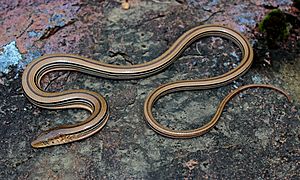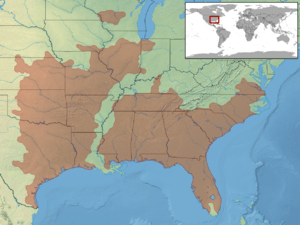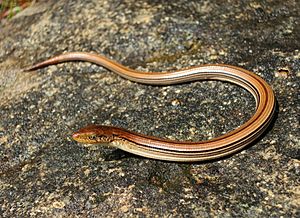Slender glass lizard facts for kids
Quick facts for kids Slender glass lizard |
|
|---|---|
 |
|
| Conservation status | |
| Scientific classification | |
| Genus: |
Ophisaurus
|
| Species: |
attenuatus
|
 |
|
| Synonyms | |
|
|
The slender glass lizard (Ophisaurus attenuatus) is a type of legless lizard. It belongs to the family called Anguidae. This lizard lives only in the United States. There are two main types, called subspecies.
People once thought this lizard was just a type of the eastern glass lizard. Its name comes from its tail, which can break off very easily. It's actually quite hard to find a slender glass lizard with a tail that hasn't been broken at some point! These lizards eat many different insects and small animals, even other small lizards. Snakes and other animals hunt them. Humans can also harm them by destroying their homes and killing their food with bug sprays. The International Union for Conservation of Nature (IUCN) says this lizard is a least-concern species, meaning it's not in danger overall. However, it is vulnerable in Iowa and endangered in Wisconsin.
Contents
What's in a Name?
Scientists first thought this lizard was a type of Ophisaurus ventralis in 1880. An American scientist named Edward Drinker Cope gave it the name Opheosaurus ventralis attenuatus. But in 1885, a British scientist, George Albert Boulenger, said it was its own unique species. Other scientists agreed with Cope for a while. Then, in 1949, another American scientist, Wilfred T. Neill, said Boulenger was right.
So, how is this lizard different? It has white spots on its back that are mostly on the edges of its scales. Other similar lizards have spots in the middle of their scales. Also, the slender glass lizard has 98 or more scales along its side fold.
The name Ophisaurus comes from Ancient Greece. Orphis means "serpent" or "reptile," and saurus means "lizard" or "reptile." The word attenuatus is Latin for "tapered," "drawn out," or "thin." This describes its long, slender body.
Different Types of Slender Glass Lizards
There are two recognized subspecies:
- Western slender glass lizard, O. a. attenuatus Baird in Cope, 1880
This lizard can grow to about 0.66 meters (26 inches) long. You can find it in woods, dry rocky hillsides, tall grass, or in burrows made by small animals. Its color helps it blend in very well with tall grass.
- Eastern slender glass lizard, O. a. longicaudus McConkey, 1952
Male eastern slender glass lizards are usually bigger than females. They have longer heads and tails. Males also have more scales on their backs and above their side folds than females. Larger males might have white stripes on their front backs, outlined in black. Smaller males and females don't have these markings.
Appearance and Body
Slender glass lizards are usually yellow to brown. They have six stripes, including one down the middle of their back. Sometimes, white spots on their scales can form light stripes. These lizards can grow to be about 0.56 to 0.91 meters (22 to 36 inches) long. Their tail makes up about two-thirds of their total body length.
Their scales are supported by small bones called osteoderms. This makes their body feel hard and stiff. They have a pointed snout and a head that doesn't stand out much from their body. Males and females are about the same size. As they get older, their markings might fade.
Unlike snakes, slender glass lizards have eyelids, so they can blink. They also have ear openings, which snakes do not. Slender glass lizards can have trouble moving on smooth surfaces. This is because they don't have the large belly scales and strong muscles that snakes use to grip and push themselves forward. A snake's body is also much more flexible than a glass lizard's.
Behavior and Habits
Slender glass lizards are mostly active during the day. They can move very quickly! If a predator catches one, the lizard might thrash around. This can cause part of its tail to break off into one or more pieces. While the predator is busy with the wiggling tail, the lizard quickly escapes.
These lizards often sleep in burrows made by other animals. They also use these burrows to hibernate during the cold months. They are active during the day when the weather is cool. But when it's hot, they are only active during dawn and dusk. Like snakes, they hibernate in a special winter den called a hibernaculum. They have also been known to dig their own burrows in sandy soil. Slender glass lizards hibernate from October until April or May.
When a predator breaks off part of its tail, the tail never fully grows back. This means its tail gets shorter each time it's attacked. They are called "glass lizards" because their tails break so easily. They can even snap off their tail without being touched! The part of the tail that grows back is tan and doesn't have the same pattern as the original tail. The broken pieces of tail will keep wiggling for a while after they break off.
There are some common myths about them. Some people used to believe that the broken tail pieces could grow into new lizards, or that they could reattach to form a new tail. This is not true. In a study from 1989, 79% of the lizards found had broken tails. It is rare to find a slender glass lizard with its entire tail. They usually don't bite when they feel threatened. When someone approaches them, they might stay still and try to blend in with the plants around them.
Where They Live
Slender glass lizards live in the central and southeastern parts of the United States. You can find them in prairies, old fields, or open woodlands, often near water. They can also sometimes be found in longleaf pine forests and around human-made debris.
Diet and Predators
Slender glass lizards eat many different insects. These include grasshoppers, crickets, and beetles. They also eat spiders, small rodents, and snails. They have even been known to eat small lizards and small snakes.
Unlike snakes, glass lizards do not have flexible jaws. This means they can only eat prey that is no bigger than their head. They often hunt underground in burrows. They have a fold of skin that can expand their body. This helps them when they are breathing, eating a large meal, or carrying eggs.
Many animals hunt slender glass lizards. These include Broad-winged hawks, red-tailed hawks, opossums, coyotes, bobcats, and raccoons. Snakes that eat them include the eastern racer (Coluber constrictor), ring-necked snake (Diadophis punctatus), prairie kingsnake (Lampropeltis calligaster), common kingsnake (Lampropeltis getula), and copperhead (Agkistrodon contortrix).
Reproduction and Life Cycle
Slender glass lizards usually mate every two years in May. Females lay about 5 to 15 oval eggs in late June or July. The mother stays with her eggs during the incubation period, which lasts about 50 to 60 days. The eggs are laid under things that can cover them, like a log or a board. The eggs hatch after about 53 days, usually in August or October.
Baby lizards, called hatchlings, are about 10–13 centimeters (4–5 inches) long. They are hard to find! These lizards become old enough to reproduce when they are three or four years old.
Conservation Status
Even though the slender glass lizard is not considered endangered across the whole United States, it is vulnerable in Iowa and endangered in Wisconsin. In Iowa, it's even against the law to capture them.
The biggest dangers to these lizards are losing their homes and their habitats being broken up by human development. Insecticides (bug sprays) are also harmful. They kill the insects that the lizards eat. The lizards can also get sick if they eat insects that have been sprayed.
The Iowa Department of Natural Resources has suggested ways to help protect the slender glass lizard. These include avoiding burning grasslands from April to October. They also recommend removing trees using machines instead of chemicals. And it's important to limit the use of bug sprays in areas where these lizards live.
Images for kids
See also
 In Spanish: Lagarto delgado de cristal para niños
In Spanish: Lagarto delgado de cristal para niños






